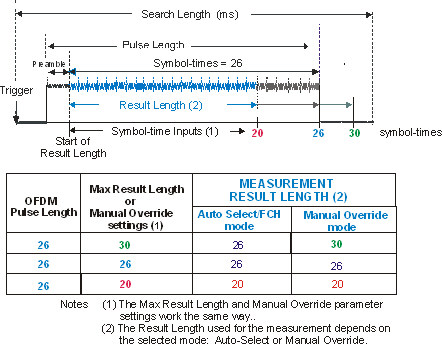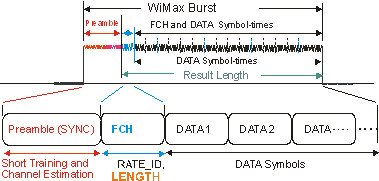Result Length Parameters (802.16 OFDM)
Result Length parameters specify how much data is acquired and demodulated. There are three selections for determining the Result Length:
This topic includes the following information:
- Comparison of , and Result Length modes
- Determining the Result Length in Automatic mode
- 802.16
OFDM IEEE 802.16a/d FCH Symbol
The amount of data included and shown by the trace data display is determined from the and text box parameters, as well as the and parameters. For more information, see Time (802.16 OFDM) trace data.
Comparison of Automatic, FCH and Manual Result Length modes
The following figure illustrates the differences between how the , and modes determine the measurement result length. The table below lists the measurement results lengths for the three Result Length modes at three different result length input settings (30, 26, and 20 symbol-times) for a burst whose pulse width is fixed at 26 symbol-times.

- 30 symbol time
example - Burst pulse width is less than the result length settings:
- mode: The VSA uses a result length of 30 and will demodulate the full 30 symbol-times even though this is 4 symbol times beyond the pulse width.
- (Frame Control Header) mode: The VSA uses a result length of 26, which is the smaller value between the Result Length FCH and the .
- mode: The VSA uses a result length of 26, which is the smaller value between the burst symbol-time and the .
- 20 and 26 symbol-time
examples - Burst pulse width is greater than or equal to the result length
settings:
- mode: The VSA uses a measurement result length equal to the Manual Override settings, which is 20 and 26 for these examples.
- (Frame Control Header) mode: The VSA uses a result length of 20 and 26, which is the smaller value between the Result Length FCH and the .
- mode: The VSA uses the smaller value between the setting anf the number of data symbol times detected within the burst as the measurement result length which is 20 and 26 for these examples (See Determining the Result Length in Automatic Mode below).
Return to Top of Page
Determining the Result Length in Automatic Mode
When Automatic is selected, the VSA compares the number of symbol-times transmitted within the burst to the Max Result Length parameter and uses the smaller value as the measurement result length.
OFDM IEEE 802.16a/d FCH Symbol
The following figure shows the IEEE Institute of Electrical and Electronics Engineers. A US-based membership organisation that includes engineers, scientists, and students in electronics and related fields. The IEEE developed the 802 series wired and wireless LAN standards. Visit the IEEE at http://www.ieee.org 802.16a/d OFDM Orthogonal Frequency Division Multiplexing: OFDM employs multiple overlapping radio frequency carriers, each operating at a carefully chosen frequency that is Orthogonal to the others, to produce a transmission scheme that supports higher bit rates due to parallel channel operation. OFDM is an alternative tranmission scheme to DSSS and FHSS. burst structure, which contains the Preamble symbols followed by the FCH symbol time and Data symbol times. The FCH symbol contains the RATE and LENGTH fields. The VSA uses the LENGTH field to determine the number of DATA symbol-times within the burst. The encoding of the FCH, single OFDM symbol, is performed with BPSK Binary phase shift keying - A type of phase modulation using 2 distinct carrier phases to signal ones and zeros. modulation of the subcarriers.

Return to Top of Page
See Also
